Focus On Global Warming——Environmental protection说课稿
- 格式:doc
- 大小:28.50 KB
- 文档页数:4
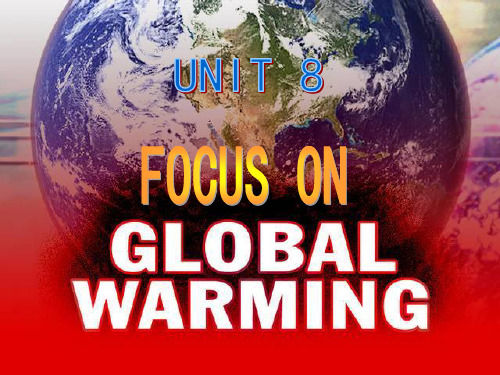
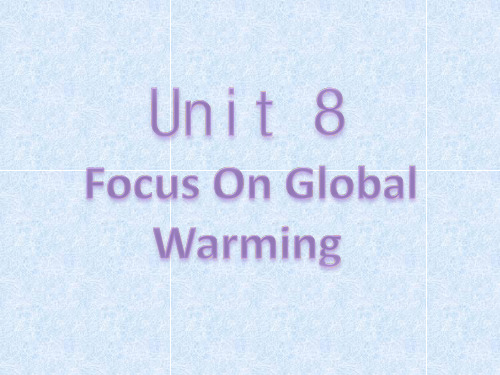
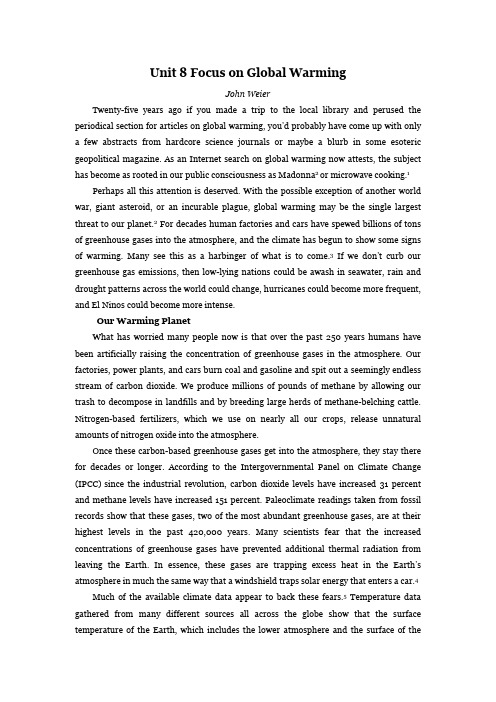
Unit 8 Focus on Global WarmingJohn WeierTwenty-five years ago if you made a trip to the local library and perused the periodical section for articles on global warming, you’d probably have come up with only a few abstracts from hardcore science journals or maybe a blurb in some esoteric geopolitical magazine. As an Internet search on global warming now attests, the subject has become as rooted in our public consciousness as Madonna2 or microwave cooking.1 Perhaps all this attention is deserved. With the possible exception of another world war, giant asteroid, or an incurable plague, global warming may be the single largest threat to our planet.2 For decades human factories and cars have spewed billions of tons of greenhouse gases into the atmosphere, and the climate has begun to show some signs of warming. Many see this as a harbinger of what is to come.3If we don’t curb our greenhouse gas emissions, then low-lying nations could be awash in seawater, rain and drought patterns across the world could change, hurricanes could become more frequent, and El Ninos could become more intense.Our Warming PlanetWhat has worried many people now is that over the past 250 years humans have been artificially raising the concentration of greenhouse gases in the atmosphere. Our factories, power plants, and cars burn coal and gasoline and spit out a seemingly endless stream of carbon dioxide. We produce millions of pounds of methane by allowing our trash to decompose in landfills and by breeding large herds of methane-belching cattle. Nitrogen-based fertilizers, which we use on nearly all our crops, release unnatural amounts of nitrogen oxide into the atmosphere.Once these carbon-based greenhouse gases get into the atmosphere, they stay there for decades or longer. According to the Intergovernmental Panel on Climate Change (IPCC)since the industrial revolution, carbon dioxide levels have increased 31 percent and methane levels have increased 151 percent. Paleoclimate readings taken from fossil records show that these gases, two of the most abundant greenhouse gases, are at their highest levels in the past 420,000 years. Many scientists fear that the increased concentrations of greenhouse gases have prevented additional thermal radiation from leaving the Earth. In essence, these gases are trapping excess heat in the Earth’s atmosphere in much the same way that a windshield traps solar energy that enters a car.4 Much of the available climate data appear to back these fears.5Temperature data gathered from many different sources all across the globe show that the surface temperature of the Earth, which includes the lower atmosphere and the surface of theocean, has risen dramatically over several decades. Worldwide measurements of sea level show a rise of 0.1 to 0.2 meters over the last century. That’s an increase of roughly 1℃every 4,000 years. Readings gathered from glaciers reveal a steady recession of the world’s continental glaciers. Taken together, all of these data suggest that over the last century the planet has experienced the largest increase in surface temperature in 1,000 years.Not surprisingly, many scientists speculate that such changes in the climate will probably result in hotter days and fewer cool days.6 According to the IPCC, land surface areas will increase in temperature over the summer months much more than the ocean. The mid-latitude to high-latitude regions in the Northern Hemisphere — areas such as the Continental United States, Canada, and Siberia — will likely warm the most. These regions could exceed mean global warming by as much as 40 percent.As far as human health is concerned, those hit hardest will probably be residents of poorer countries that do not have the funds to fend against changes in climate.7 A slight increase in heat and rain in equatorial regions would likely spark an increase in vector-borne diseases such as malaria. More intense rains and hurricanes could cause more severe flooding and more deaths in coastal regions and along riverbeds. Even a moderate rise in sea level could threaten the coastlines of low-lying islands such as the Maldives. All across the globe, hotter summers could lead to more cases of heatstroke and deaths among those who are vulnerable, such as older people with heart problems. The warmer temperatures may also lead to higher levels of near-surface ozone from cars and factories, which would likely cause more perilous air quality days and hospital admissions for those with respiratory problems.Taking ActionsFortunately, we can take actions to slow down global warming.8Global warming results primarily from human activities that release heat-trapping gases and particles into the air. The most important causes include the burning of fossil fuels such as coal, gas, and oil, and deforestation. To reduce the emission of heat-trapping gases like carbon dioxide, methane, and nitrous oxides, we can curb our consumption of fossil fuels, use technologies that reduce the amount of emissions wherever possible, and protect the forests in the world.We can also do things to mitigate the impacts of global warming and adapt to those most likely to occur,9 e.g., through careful planning and other strategies that reduce our vulnerability to global warming.But we can’t stop there. We are also advocating policies that will combat globalwarming over the long term, things like clean cars that run on alternative fuels, environmentally responsible renewable energy technologies, and stopping the clear-cutting of valuable forests.Clearly, global warming is a huge problem. It will take everyone — governments, industry, communities and individuals working together to make a real difference. Fortunately you can be part of them.关注全球气候变暖二十五年前,如果你想去当地的图书馆通过各种期刊搜索关于全球气候变暖的文章的话,很可能你只能找到一些刊登在核心自然科学期刊或非常专业的地理科学杂志上的同类文章的摘要。

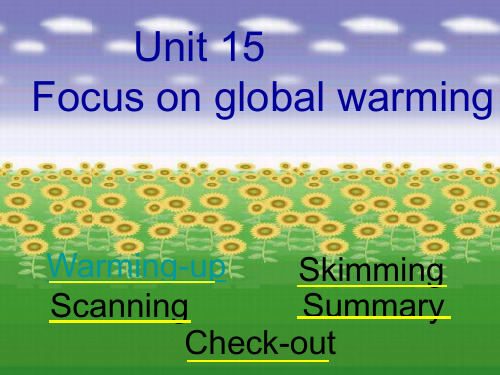
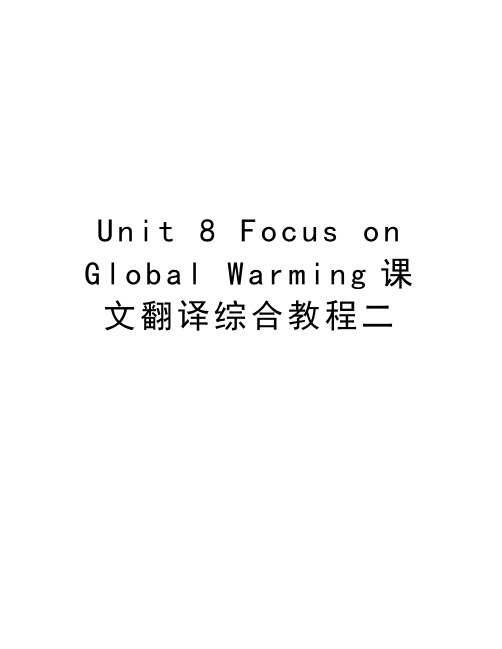
U n i t8F o c u s o n G l o b a l W a r m i n g课文翻译综合教程二Unit 8 Focus on Global WarmingJohn WeierTwenty-five years ago if you made a trip to the local library and perused the periodical section for articles on global warming, you’d probably have come up with only a few abstracts from hardcore science journals or maybe a blurb in some esoteric geopolitical magazine. As an Internet search on global warming now attests, the subject has become as rooted in our public consciousness as Madonna2 or microwave cooking.1Perhaps all this attention is deserved. With the possible exception of another world war, giant asteroid, or an incurable plague, global warming may be the single largest threat to our planet.2 For decades human factories and cars have spewed billions of tons of greenhouse gases into the atmosphere, and the climate has begun to show some signs of warming. Many see this as a harbinger of what is to come.3If we don’t curb our greenhouse gas emissions, then low-lying nations could be awash in seawater, rain and drought patterns across the world could change, hurricanes could become more frequent, and El Ninos could become more intense.Our Warming PlanetWhat has worried many people now is that over the past 250 years humans have been artificially raising the concentration of greenhouse gases in the atmosphere. Our factories, power plants, and cars burn coal and gasoline and spit out a seemingly endless stream of carbon dioxide. We produce millions of pounds of methane by allowing our trash to decompose in landfills and by breeding large herds of methane-belching cattle. Nitrogen-based fertilizers, which we use on nearly all our crops, release unnatural amounts of nitrogen oxide into the atmosphere.Once these carbon-based greenhouse gases get into the atmosphere, they stay there for decades or longer. According to the Intergovernmental Panel on Climate Change (IPCC)since the industrial revolution, carbon dioxide levels have increased 31 percent and methane levels have increased 151 percent. Paleoclimate readings taken from fossil records show that these gases, two of the most abundant greenhouse gases, are at their highest levels in the past 420,000 years. Many scientists fear that the increased concentrations of greenhouse gases have prevented additional thermal radiation from leaving the Earth. In essence, these gases are trapping excess heat in the Earth’satmosphere in much the same way that a windshield traps solar energy that enters a car.4Much of the available climate data appear to back these fears.5 Temperature data gathered from many different sources all across the globe show that the surface temperature of the Earth, which includes the lower atmosphere and the surface of the ocean, has risen dramatically over several decades. Worldwide measurements of sea level show a rise of 0.1 to 0.2 meters over the last century. That’s an increase of roughly 1℃ every 4,000 years. Readings gathered from glaciers reveal a steady recession of the world’s continental glaciers. Taken together, all of these data suggest that over the last century the planet has experienced the largest increase in surface temperature in 1,000 years.Not surprisingly, many scientists speculate that such changes in the climate will probably result in hotter days and fewer cool days.6 According to the IPCC, land surface areas will increase in temperature over the summer months much more than the ocean. The mid-latitude to high-latitude regions in the Northern Hemisphere — areas such as the Continental United States, Canada, and Siberia — will likely warm the most. These regions could exceed mean global warming by as much as 40 percent.As far as human health is concerned, those hit hardest will probably be residents of poorer countries that do not have the funds to fend against changes in climate.7 A slight increase in heat and rain in equatorial regions would likely spark an increase in vector-borne diseases such as malaria. More intense rains and hurricanes could cause more severe flooding and more deaths in coastal regions and along riverbeds. Even a moderate rise in sea level could threaten the coastlines of low-lying islands such as the Maldives. All across the globe, hotter summers could lead to more cases of heatstroke and deaths among those who are vulnerable, such as older people with heart problems. The warmer temperatures may also lead to higher levels of near-surface ozone from cars and factories, which would likely cause more perilous air quality days and hospital admissions for those with respiratory problems.Taking ActionsFortunately, we can take actions to slow down global warming.8 Global warming results primarily from human activities that release heat-trapping gases and particles into the air. The most important causes include theburning of fossil fuels such as coal, gas, and oil, and deforestation. To reduce the emission of heat-trapping gases like carbon dioxide, methane, and nitrous oxides, we can curb our consumption of fossil fuels, use technologies that reduce the amount of emissions wherever possible, and protect the forests in the world.We can also do things to mitigate the impacts of global warming and adapt to those most likely to occur,9 e.g., through careful planning and other strategies that reduce our vulnerability to global warming.But we can’t stop there. We are also advocating policies that will combat global warming over the long term, things like clean cars that run on alternative fuels, environmentally responsible renewable energy technologies, and stopping the clear-cutting of valuable forests.Clearly, global warming is a huge problem. It will take everyone —governments, industry, communities and individuals working together to make a real difference. Fortunately you can be part of them.关注全球气候变暖二十五年前,如果你想去当地的图书馆通过各种期刊搜索关于全球气候变暖的文章的话,很可能你只能找到一些刊登在核心自然科学期刊或非常专业的地理科学杂志上的同类文章的摘要。
Focus on global warmingTwenty-five years ago if you made a trip to the local library and perused the periodical section for articles on global warming, you'd probably have come up with only a few abstracts from hardcore science journals or maybe a blurb in some esoteric geopolitical magazine. As an Internet search on global warming now attests, the subject has become as rooted in our public consciousness as Madonna or microwave cooking.Perhaps all this attention is deserved. With the possible exception of another world war, a giant asteroid, or an incurable plague, global warming may be the single largest threat to our planet. For decades human factories and cars have spewed billions of tons of greenhouse gases into the atmosphere, and the climate has begun to show some signs of warming. Many see this as a harbinger of what is to come. If we don't curb our greenhouse gas emissions, then low-lying nations could be awash in seawater, rain and drought patterns across the world could change, hurricanes could become more frequent, and El Ninos could become more intense.Our Warming PlanetWhat has worried many people now is that over the past 250 years humans have been artificially raising the concentration of greenhouse gases in the atmosphere. Our factories, power plants, and cars burn coal and gasoline and spit out a seemingly endless stream of carbon dioxide. We produce millions of pounds of methane by allowing our trash to decompose in landfills and by breeding large herds of methane-belching cattle. Nitrogen-based fertilizers, which we use on nearly all our crops, release unnatural amounts of nitrogen oxide into the atmosphere.Once these carbon-based greenhouse gases get into the atmosphere, they stay there for decades or longer. According to the Intergovernmental Panel on Climate Change (IPCC), since the industrial revolution, carbon dioxide levels have increased 31 percent and methane levels have increased 151 percent. Paleoclimate readings taken from fossil records show that these gases, two of the most abundant greenhouse gases, are at their highest levels in the past 420,000 years. Many scientists fear that the increased concentrations of greenhouse gases have prevented additional thermal radiation from leaving the Earth. In essence, these gases are trapping excess heat in the Earth's atmosphere in much the same way that a windshield traps solar energy that enters a car.Much of the available climate data appear to back these fears. Temperature data gathered from many different sources all across the globe show that the surface temperature of the Earth, which includes the lower atmosphere and the surface of the ocean, has risen dramatically over several decades. Worldwide measurements of sea level show a rise of to meters over the last century. That's an increase of roughly 1℃ every 4,000 years. Readings gathered from glaciers reveal a steady recession of the world's continental glaciers. Taken together, all of these data suggest that over the last century the planet has experienced the largest increase in surface temperature in 1,000 years.Not surprisingly, many scientists speculate that such changes in the climate will probably result in hotter days and fewer cool days. According to the IPCC, land surface areas will increase in temperature over the summer months much more than the ocean. The mid-latitude to high-latitude regions in the Northern Hemisphere—areas such as the continental United States, Canada, and Siberia—will likely warm the most. These regions could exceed mean global warming by as much as 40 percent.As far as human health is concerned, those hit hardest will probably be residents of poorer countries that do not have the funds to fend against changes in climate.A slight increase in heat and rain in equatorial regions would likely spark an increase in vector-borne diseases such as malaria. More intense rains and hurricanes could cause more severe flooding and more deaths in coastal regions and along riverbeds. Even a moderate rise in sea level could threaten the coastlines of low-lying islands such as the Maldives. All across the globe, hotter summers could lead to more cases of heat stroke and deaths among those who are vulnerable, such as older people with heart problems. The warmer temperatures may also lead to higher levels of near-surface ozone from cars and factories, which would likely cause more perilous air quality days and hospital admissions for those with respiratory problems.Taking actionsFortunately, we can take actions to slow global warming. Global warming results primarily from human activities that release heat-trapping gases and particles into the air. The most important causes include the burning of fossil fuels such as coal, gas, and oil, and deforestation. To reduce the emission of heat-trapping gases like carbon dioxide, methane, and nitrous oxide, we can curb our consumption of fossil fuels, use technologies that reduce the amount of emissions wherever possible, and protect the forests in the world.We can also do things to mitigate the impacts of global warming and adapt to those most likely to occur, ., through careful planning and other strategies that reduce our vulnerability to global warming.But we can't stop there. We are also advocating policies that will combat global warming over the long term, things like using clean cars that run on alternative fuels, environmentally responsible renewable energy technologies, and stopping the clear-cutting of valuable forests.Clearly, global warming is a huge problem. It will take everyone—governments, industry, communities and individuals working together to make a real difference. Fortunately you can be part of them.。
Global WarmingGlobal warming is an environmental threat to the entire world that we should know about. The world is being hot day by day because of greenhouse effects and its gas. We, humans, are responsible for this. We should be aware of this. Otherwise, the world will be a place where people won’t be able to live.The level of carbon dioxide is increasing day by day. The biggest reason behind it is deforestation. We need to focus on tree plantation. If you plant more and more trees, it will add oxygen in nature and make the world a better place. Global warming is a really threatening issue right now for the entire world. The uprising level of carbon dioxide is the biggest reason for global warming. Experts are saying that the world after 100 years will be really hot, which is pretty much hard tolive for our future generation.Most of the reason behind global warming is human-made. We can solve them if we concern about the matter and take some action. We know tree takes carbon dioxide that we leave, and it’s a really dangerous element of the air for human.When there is not enough tree or plants to take our carbon dioxide, the environment get hot. So we have to handle this uprising level of carbon dioxide. We can do this only with tree plantation. We need to do some campaign and make people aware of the future. So that everyone can save themselves from the problem. Greenhouse effect and deforestation has been the biggest reason behind global warming. The earth is a beautiful place for a human, but its temperature is being high day by day. This calls ‘Global Warming’. That’s mean the entire world is being warmer. It’s not a good thing for the future.According toexpert opinion, the world after a couple of hundred years will be unable to live in the level of carbon dioxide keeps increasing. Could you imagine, how threatening is this? Our future generation is in deep danger. We have to gift them a better and safer world.There are still some solutions that could bring some changes. Climate change is one of the biggest reasons behind it. As you are following the seasons are really changing every year, they are changing their effects. Its climate change. The entire world will face this. Few counties will sink under the sea because of that effect.But still, we can prevent this if we become aware. Most of the situations are made by a human. Several types of pollution and deforestation are the main reason for global warming and climate change. We need to stop it. Everyone should startplanting more and more trees. That’s the biggest solution.。
focusonglobalwarming全文翻译25年前,如果你走进当地一家图书馆想细读一些跟全球变暖有关的书时,你可能只会从核心科学杂志上找到点摘要或在深奥的地理杂志上看到点简介。
而如今,网上搜索结果证明全球变暖这一问题已经成为像麦当娜和微波炉一样的公众意识根植在人们心中了。
或许这种注意是值得的。
因为除了可能发生的另一场世界大战,大行星撞地球过一场致命的瘟疫外,全球变暖可能是这个行星的最大威胁。
几十年来,人类工厂和汽车向大气排放了上亿吨温室气体,气候已经出现变暖的征兆。
许多人认为这是即将发生什么事情的预示。
如果我们不能抑制温室气体的排放,那些地势低的地区可能会被海水淹没,全球性的暴雨和干旱会随之而来,飓风也会变得越来越频繁,厄尔尼诺现象也会愈演愈烈。
现在,最让人们担心的是,在过去250年里,人们一直在人为地增加大气中温室气体的浓度。
我们的工厂,电厂,汽车燃烧煤和汽油时排放出了无穷无尽的二氧化碳。
通过在废弃填埋厂里填埋垃圾,并大量饲养会呼出甲烷的牛群,我们已经制造了数百万磅的甲烷。
我们用在农作物上的以氮元素为主的化肥,向大气排放了非常量的氮化铵气体。
一旦那些碳化气体进入大气,它们就会在那呆上几十年甚至更长时间。
从政府研究小组对气候变化的研究来看,二氧化碳的含量已经增长致31%,甲烷是151%。
从化石对地质气候的记录来看,对比过去的42万年,如今这两种温室气体量已经达到史上最大值。
许多科学家担心温室气体浓度的增加会阻碍地球上多余的热辐射的散发,实质上,这些气体正在阻碍大气能量的散发,这和汽车挡风玻璃阻碍阳光热量进入车内的原理差不多。
我们得到的大量的气候数据证实了我们的担心。
不同来源测出的全球温度数据显示地球表面温度——包括较低气层以及大洋表面温度这些年来都在急剧增加。
世界范围内的海平面高度测量结果显示比上世纪上涨了0.1到0.2米,也就是说海水的温度每4000年就高1度。
冰川研究结果表明,全球的大陆冰川正处在稳步消融期。
Today, we will learn Unit 15, Reading, Section one “Focus on global warming”.
Before we learn this text, let’s review our first class.
I will reintroduce the environmental situation today, especially the aspect on global warming.
Today the quality of our natural environment has become an important issue. The world population is rising so quickly that the world has become too crowded. We are using up our natural resources and at the same time polluting our environment with dangerous chemicals. If we continue to do this, life on earth cannot survive.
Concerned people have made some progress in environmental protection. Governments of many countries have established laws to protect the air, forests and sea resources and to stop environmental pollution.
More measures still should be taken to solve environmental problems. People should be further educated to recognize the importance of the problems, to use modern methods of birth control, to conserve(保存)our
natural resources and recycle our products. We are sure that we can have a better and cleaner place in the future.
Now let’s look over some words that will appears in this text.
Look at your English book, page 171, from “focus” to “fortunate” appears in section 1. I will read them for you. Follow me, twice.
I will give you 5’ to review these words, and then, I will ask some you to have little quizzes.
In order to have a deep impression in these words, I’ll show you some pictures and sentences.
There are also some other vocabularies about our environment protection.
After we have mastered these words, we will discuss a topic about our school environment: What can we do to protect our school environment?
We do not need to do important things. We can start out small to protect
our environment.
The very first thing for everyone is to stop dumping rubbish anywhere they like. Throwing rubbish seems to be the favorite pastime of everyone. So we see piles of rubbish on road sides, in ditches and drains, in back lanes and often on main roads too.
We do not spit on the ground. We should spit on the tissue and throw it into the rubbish bin. We stay at our classrooms for a long time every day. So we should keep our classrooms clean, or we will get sick. As a student, it is our duty to keep our classrooms clean too.
Empty cans and bottles, sweet wrappers, plastic bags full of smelly stuff, dead animals, broken toys, broken TV sets, old computers, food, old cars and kitchen sinks are items that can be found in the rubbish dumps. Perhaps we could recycle the things we use instead of simply throwing them away. We could, for example, reuse glass, metals and plastics. We could cook only what is necessary instead of throwing what we could not eat. We could keep our cars and sinks in good working order instead of abusing them as many of us do now. Then we would have less rubbish to throw. Consequently there would be less rubbish dumps and less pollution.
In this class, we have discussed a serious problem ——Global Warming. We have known that how to reduce greenhouse gases is an important task. We should do our best to protect our earth the only planet. We also learned some words and phases in this class.
Homework: Review key words and phrases, useful expressions and structures after class. Preview the text.。